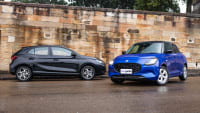Ferrari’s top-dog 12-cylinder models have always commanded an exclusive, exotic place in the pantheon of cars, and they are surely the pride of Italy. In 1984 the new F110 model “Testarossa” debuted, featuring a mid-mounted 390hp (287kW) Tipo 113B flat-12 engine to keep weight low in the wide-set chassis.
The name reference’s a famous racing car from Ferrari’s history; the 1950s 250 Testa Rossa (“red head”), which is now one of the most collectable and valuable cars ever made. The rocker cover on each of the double-overhead cam cylinder head in the 1984 model were painted bright red in a classic crinkle finish, leading to the tie back to the famous Italian “red head”.
Enzo’s ‘80s Testarossa followed Ferrari’s first mid-engined 12-cylinder road car, the Berlinetta Boxer 512i, and its design was centred around fixing many of the complaints the 512 copped. The Testarossa was much larger than its predecessor, with wide straked side pods housing radiators to keep the engine cool and not require hot piping to run through the cabin like the BB mode.
While the 1980s were a heady time full of fast money and neon polo shirts, the Testarossa proved to be a seriously rare beast in Australia. Only a handful were sold new as Australian-delivered models through the years, and it was one of the most expensive new cars for sale Down Under for many years.
Sprinting from zero to 100km/h, the Testarossa stopped the clocks after just 5.8-seconds, which was scintillating for 1984, while the 13.5-second quarter-mile time was fairly jaw-dropping. This was made more astounding by the fact the Big Dawg Ferrari tipped the scales at over 1700kg!
They were certainly one of the fastest ways to cross our wide, brown land in the 1980s, with a top speed nudging 300km/h. However, they aren’t the easiest cars to drive thanks to long front overhang, poor exterior visibility, and high-speed nose lift. As with most older Italian supercars, they’re also not the last word of reliability or ease of driving thanks to heavy steering, hot temperatures in the cabin, and a difficult gearshift.
The cost of Testarossas has shot up in recent times, following the model’s blooming popularity across Europe and America. If you want to buy an original Australian-delivered Testarossa you’ll need deep pockets, to the tune of approximately half a million dollars, or more.
UK or Hong Kong imports and left-hand-drive examples are less highly sought-after Down Under, but have a strong appeal overseas. As with all 12-cylinder Ferraris the market for these cars is worldwide, and the values are set to only go up from here as examples get rarer through age. Early models with a high-mount, single rear-vision mirror, known as ‘Periscope’ models, are particularly sought-after.
The original Testarossa was comprehensively updated for 1991 as the 512TR – TR for Testa-Rossa – which fixed many minor complaints, and then again in 1994 as the F512M. The F512M proved to be the final mid-engined flat-12 Ferrari supercar, as the front-engined V12 550 GT replaced it in 1997.
Interestingly, the Testarossa (and 512TR and F512M) didn’t have a model which was used in racing. There was one convertible Testarossa built, however, for the ultimate 1980s statement of excess.
.jpg)
.jpg)

.jpg)
.jpg)
.jpg)





.jpg)



_0.jpg)
.jpg)
.jpg)
.jpg)
.jpg)
.jpg)

.jpg)

